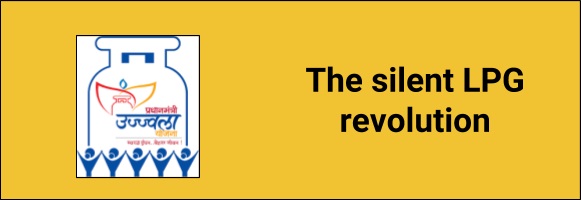(HOT) UPSC Current Affairs 2025 PDF
NEW! The Gist (NOV-2025) | E-BOOKS
The silent LPG revolution - Ujjwala Yojana : Important Topics for UPSC Exams

The silent LPG revolution - Ujjwala Yojana : Important Topics for UPSC Exams
Why in News?
-
The LPG Panchayat was organised by the Ministry of Petroleum and Natural Gas as an awareness drive with an aim to provide a platform for LPG consumers to interact with each other, promote mutual learning and share experiences and the Ministry intends to conduct 1 lakh such Panchayats across India before March 31, 2019; each LPG Panchayat will have around 100 members.
-
On February 7, 2018 the Centre has decided to ramp up the target of 5 crore to eight crore and allocated an additional ₹4,800 crore to this end after setting aside ₹8,000 crore during the inception of the scheme.
Pradhan Mantri Ujjwala Scheme (PMUY)
-
Pradhan Mantri Ujjwala Scheme (PMUY) – the scheme for providing LPG connections to the women of Below Poverty Line (BPL) households.
-
Scheme was launched in May 2016.
Importance of Ujjwala Scheme & LPG
-
Ujjawala Yojana is strengthening women’s empowerment and also enabling rural women to escape the drudgery and negative health effects of using firewood and PMUY is rightly seen as one that lifts the health and quality of life of rural women.
-
The Economic Survey mentions that on an average, women spend around 374 hours every year for collection of firewood, thus LPG saves cooking time and this extra time can be utilised in some income generating activity.
-
Factors such as the difference in the taste of food when prepared on chulhas (wood-fired stoves) and the ease of using cook-stoves, were key in determining the popularity of cook-stoves over traditional methods.
-
LPG as cooking fuel has its advantages, those who have access to alternative cooking fuels – wood, cowdung cakes – continue to use it as well
How Ujjawala Scheme works
-
The customer, however, has to pay for the LPG stove and first refill charges. She can make an upfront payment or get into an EMI with the oil marketing company to pay for the LPG stove, or the first refill.

Buy Printed Complete Study Materials for UPSC IAS PRELIMS Exam
Online Crash Course for UPSC PRE Exam
Issue involved
-
The issue of pricing concerns all beneficiaries across the country.
-
Even though the subsidy amount is transferred almost immediately to account through Direct Benefit Transfer (DBT), but one need to save for the refill.
-
The scheme also marks a paradigm policy shift, from improving the quality of chulhas to shifting away from it altogether.
-
While more than 15 percent of rural households use LPG, firewood remains the dominant fuel.
Refill Riddle
-
The Economic Survey 2017-18 claims that 79 per cent of the PMUY beneficiaries return for refills, taking as many as four refills per year on an average which is impressive.
-
Out of the total 25 crore-plus registered customers, 22 crores are live. Of this 22, about 12 crores are urban and about 10 crores urban plus rural (including those under Ujjwala).
-
For the urban market, the annual average consumption pattern is seen as 7-7.5 cylinders per household.
-
For rural, urban (which includes small towns), including Ujjwala beneficiaries, it is about 4-6 cylinders annually.
Successes and challenges
-
By the number of connections issued, PMUY can be considered as a success as an impressive 3.3 crore Ujjwala connections have been issued since the inception of the scheme on May 1, 2016, against the target of five crore connections by 2020.
-
Govt has also decided to expand the scope of beneficiaries to forest dwellers, tea garden tribes and island populations and going beyond the SECC-BPL grid will improve the viability of the scheme by defraying costs.
-
Instead of offering non-BPL households subsidy, an initial loan can help. With oil prices on the rise, the price of subsidised LPG will become a key issue in order to retain refill rates.
-
Oil marketing companies, too, have a role to play in checking logistics costs.
-
The GiveItUp scheme is expected to keep subsidies in check.
-
More private players are entering the commercial packed LPG segment as well and entire business of new LPG cylinders are in the hands of private companies.
-
The rural LPG distribution is not an attractive business model, as margins are low.
Socio-economic dimension
-
A report, ‘Access to Clean Cooking Energy in India’, by CEEW, says: “In 2016, the International Energy Agency estimated that of the global total of 3.5 million premature annual deaths from household air pollution (HAP), India alone is home to one million.”
Way Forward for LPG Customers
-
Behavioural change is also required, as women have to get used to LPG since use of alternative fuels allowed the women to sit and cook, while when using LPG as a fuel one has to stand. This calls for change in practice. Sitting and cooking with LPG is also a safety issue.
MODEL QUESTIONS :
Q.Do you think that Ujjawala Yojana can become a game changer in bringing a silent revolution.
Discuss the advantages of Ujjawala Yojana and also mention the limitation thereof?
Q. Which of the following is NOT a provision under PM Ujjawala Yojana?
-
It is being implemented by Ministry of Petroleum and Natural Gas.
-
Scheme was launched in May 2016.
-
LPG connections to be provided to the women of Below Poverty Line (BPL) households.
-
Target of Ujjawla Yojana has been ramped up from 5 crore to 10 crore.
Answer-D

